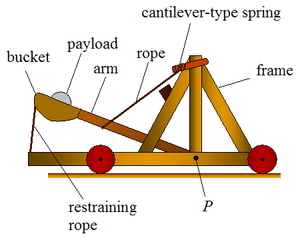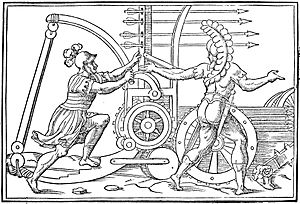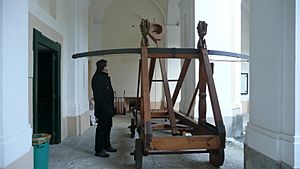Catapult facts for kids
A catapult is a cool machine that launches things really far! It doesn't use gunpowder or other fuels. Instead, it uses stored energy to throw objects. Think of it like a giant slingshot! Most catapults work by slowly building up energy, often by twisting ropes, bending wood, or stretching elastic materials. Then, they suddenly release this energy to launch their payload.
Catapults have been used for a very long time, especially in wars. They were super effective for attacking castles and cities. Today, the word "catapult" can mean anything from a small slingshot you hold in your hand to a huge machine that helps launch airplanes from a ship!
The first catapults appeared around the 7th century BC. King Uzziah of Judah, for example, had machines on the walls of Jerusalem that could shoot "great stones." Catapults are even mentioned in ancient Indian texts. In China, the mangonel, a type of catapult, showed up in the 5th century BC. The ancient Greeks also invented catapults in the early 4th century BC and used them in battles.
Contents
What Does 'Catapult' Mean?
The word 'catapult' comes from the Latin word 'catapulta'. This word itself came from the Greek word katapeltēs. It's made of two parts: kata, meaning "downwards," and pallō, meaning "to toss" or "to hurl." So, it literally means "to hurl downwards"! The ancient Greeks and people in ancient India were among the first to invent and use these machines.
Ancient Greek and Roman Catapults


Catapults and crossbows were closely related in ancient Greece. Early catapults were basically stronger bows designed to shoot arrows further and with more power. A historian named Diodorus Siculus wrote about a mechanical arrow-firing catapult that was invented by Greeks in 399 BC. This weapon was soon used in a battle against Motya, a city in Sicily.
An inventor named Hero of Alexandria said that these weapons were inspired by an earlier foot-held crossbow called the gastraphetes, or "belly-bow." This crossbow could store a lot of energy. Another writer, Biton, described even more advanced versions of the gastraphetes that could launch two missiles at once!
Around 200 BC, a detailed theory about how catapults worked was developed. It said that all parts of a catapult, including the weight of the projectile, should be proportional to the size of its springs. This shows how much ancient engineers used geometry and physics to improve their war machines.
By the mid-4th century BC, Greeks were using arrow-shooting machines more often. An old record from Athens from 338 to 326 BC lists many catapults with different sized bolts and springs made of animal tendons. This is important because it shows they switched to "torsion" catapults. These catapults used twisted ropes for power and were much stronger than crossbows. They became the main type of artillery for both Greeks and Romans.
Even kids in ancient Greece learned how to use catapults! An old inscription from the island of Ceos talks about "catapult shooting competitions for the young." Catapults were used in battles by Philip II of Macedon and his son, Alexander the Great, who used them both in open battles and during sieges of cities.
The Romans started using catapults in their wars around the 3rd and 2nd centuries BC. The Roman arcuballista was like a giant crossbow. Later, Romans even put ballista catapults on their warships.
Other Ancient Catapults
- Egypt (19th century BC): The walls of the Buhen fortress had platforms that might have been used for siege weapons.
- Judah (c. 750 BC): King Uzziah built machines to "shoot great stones."
- India (between 484 and 468 BC): Ajatashatru used catapults in his battles against the Licchavis.
- China (between 500 and 300 BC): The Chinese used mangonels, which could throw hollow logs filled with burning charcoal at enemies. These mangonels later spread to other parts of the world, including the Middle East and Europe.
Medieval Catapults
During the Middle Ages, castles and fortified cities with strong walls were very common. Catapults were important siege weapons used to attack these defenses. Besides trying to break down walls, catapults could also throw burning objects or even diseased animal carcasses over the walls to spread fear and sickness inside.
However, defensive techniques got much better in the Middle Ages. Walls became stronger, and it became harder for catapults to cause much damage. For example, during the Viking siege of Paris in 885–886 AD, both sides used many types of catapults, but they didn't do much good, and the siege failed.
Modern Uses of Catapults
Military Use
The last time catapults were widely used in war was during World War I. In the trenches, soldiers used small catapults to throw hand grenades across "no man's land" into enemy trenches. Later, small mortars replaced these catapults.
In the 1840s, when rubber could be made stronger (called vulcanized rubber), people started making small hand-held catapults. These were often made from Y-shaped sticks or sold in stores. They became very popular with kids and teenagers and are also known as slingshots.
Today, special catapults called aircraft catapults are used to launch planes from aircraft carriers or short runways. Ships also use them to launch things like torpedoes. Small catapults, called "traps," are still used in the sport of clay pigeon shooting to launch clay targets into the air.
Entertainment
In the 1990s and early 2000s, a very powerful catapult called a trebuchet was used to launch people into the air for fun! This activity was stopped because it was too dangerous, and some people got hurt or even died. Safety is super important!
Early launched roller coasters also used a catapult system to get their speed. These systems have now been replaced by newer technologies like flywheels and linear motors.
Pumpkin chunking is another popular use for catapults today. In this fun competition, people build machines to see who can launch a pumpkin the farthest!
See also
 In Spanish: Catapulta para niños
In Spanish: Catapulta para niños








